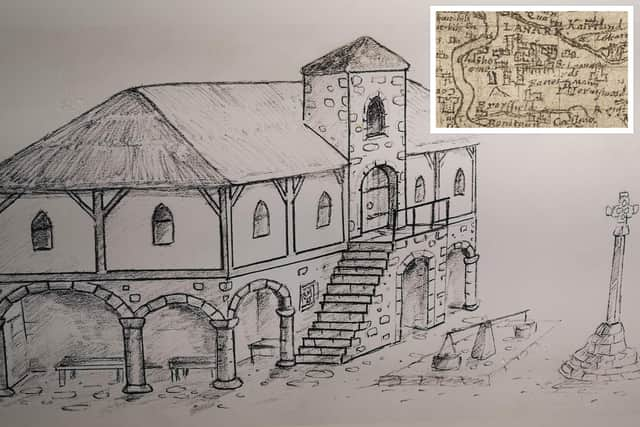100 guineas created a new meeting venue in the heart of Lanark
and live on Freeview channel 276
The first records written in 1488 refer both to the repairs being made to the building as well as a description of the booths/shops next to it.
In 1570 Thomas Twaddle was engaged to build a two storied building with space on the ground floor for shops/booths. The roof was made of blue ‘edes’ – a term for local greywacke slate. This was to replace the one which existed in 1488.
Advertisement
Hide AdAdvertisement
Hide AdThough Twaddle’s building does not survive, we get an idea of what it looked like from Timothy Pont’s map of Lanarkshire.


This is a very useful map in that Pont takes care to record in detail some of the prominent features in each burgh. Thanks to his work, we can see that there was a tower at one end of the Tolbooth, this would contain the town clock – very important since few people had a clock let alone a pocket watch.
Near the Tolbooth would be the Town Cross and the Tron which was a weighing machine. Several burghs still have their town/mercat cross but none of them have a Tron.
Lanark’s Mercat Cross disappeared years ago; however, the head of it still survives in the eastern gable of the Tolbooth.
Advertisement
Hide AdAdvertisement
Hide AdIt was several centuries before a new Tolbooth was built. There was some need to do this as the 16th century building was falling apart due to poor maintenance.
The prison in the Tolbooth was in such a state that prisoners chose to remain in it if they wanted to avoid the wrath of their family for getting drunk yet again!
Several notable prisoners also escaped from the prison including Deacon Convenor Inglis who in 1658 opposed the creation of the Guildry. A mob of Lanarkians rescued him.
Most of the prisoners were debtors, including Lady Birkhill who managed to escape in 1701.
Advertisement
Hide AdAdvertisement
Hide AdEventually money was spent on repairing the prison in 1714 at the time of the first Jacobite uprising.
The Tolbooth was also the place for important proclamations; the earliest on record was of local Jacobite supporters including Alexander Halden who forced Bailles William Wyld and Christopher Bannatyne to proclaim James II as king on Christmas Day 1745.
Part of the present Tolbooth was erected in the late 18th century when the local gentry gave Lanark Burgh Council the sum of one hundred guineas to make a decent meeting chamber on the second floor.
This was an important offer as the local gentry and Lanark Burgh Council had been at loggerheads for a number of years. This happened in 1779.
Advertisement
Hide AdAdvertisement
Hide AdThe later years of the 18th century saw a dramatic improvement o100f the fortunes of the Royal Burgh with the building of New Lanark and the economic growth of Lanark with the construction of the Clydesdale Inn.
The room where the Het Pint takes place was to be the place where in 1820 gentleman from the County of Lanark met to discuss Robert Owen’s plans for the building of a model village near Dalziel to be called ‘Orbiston ’.
Don’t miss the last installment of the Tolbooth’s history, which will be featured in next week's Gazette.